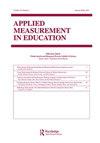Evaluating Human Scoring Using Generalizability Theory
IF 1.1
4区 教育学
Q3 EDUCATION & EDUCATIONAL RESEARCH
引用次数: 2
Abstract
ABSTRACT Many high-stakes examinations in the United Kingdom (UK) use both constructed-response items and selected-response items. We need to evaluate the inter-rater reliability for constructed-response items that are scored by humans. While there are a variety of methods for evaluating rater consistency across ratings in the psychometric literature, we apply generalizability theory (G theory) to data from routine monitoring of ratings to derive an estimate for inter-rater reliability. UK examinations use a combination of double or multiple rating for routine monitoring, creating a more complex design that consists of cross-pairing of raters and overlapping of raters for different groups of candidates or items. This sampling design is neither fully crossed nor is it nested. Each double- or multiple-scored item takes a different set of candidates, and the number of sampled candidates per item varies. Therefore, the standard G theory method, and its various forms for estimating inter-rater reliability, cannot be directly applied to the operational data. We propose a method that takes double or multiple rating data as given and analyzes the datasets at the item level in order to obtain more accurate and stable variance component estimates. We adapt the variance component in observed scores for an unbalanced one-facet crossed design with some missing observations. These estimates can be used to make inferences about the reliability of the entire scoring process. We illustrate the proposed method by applying it to real scoring data.用概化理论评价人的得分
摘要在英国,许多高风险考试既使用构建的回答项目,也使用选择的回答项目。我们需要评估由人类评分的构建反应项目的评分者间可靠性。虽然在心理测量学文献中有多种方法可以评估评分者在不同评分之间的一致性,但我们将可推广性理论(G理论)应用于日常评分监测的数据,以得出评分者间可靠性的估计值。英国考试采用双重或多重评分相结合的方式进行日常监测,形成了一种更复杂的设计,包括评分者的交叉配对和不同考生组或项目的评分者的重叠。这种抽样设计既不是完全交叉的,也不是嵌套的。每个双分或多分项目都有一组不同的候选人,每个项目的抽样候选人数量各不相同。因此,标准的G理论方法及其用于评估评级机构间可靠性的各种形式,不能直接应用于操作数据。我们提出了一种方法,该方法采用给定的双倍或多重评级数据,并在项目级别分析数据集,以获得更准确和稳定的方差分量估计。我们将观察到的分数中的方差分量调整为具有一些缺失观察的不平衡单方面交叉设计。这些估计可用于推断整个评分过程的可靠性。我们通过将所提出的方法应用于真实的评分数据来说明它。
本文章由计算机程序翻译,如有差异,请以英文原文为准。
求助全文
约1分钟内获得全文
求助全文
来源期刊

Applied Measurement in Education
Multiple-
CiteScore
2.50
自引率
13.30%
发文量
14
期刊介绍:
Because interaction between the domains of research and application is critical to the evaluation and improvement of new educational measurement practices, Applied Measurement in Education" prime objective is to improve communication between academicians and practitioners. To help bridge the gap between theory and practice, articles in this journal describe original research studies, innovative strategies for solving educational measurement problems, and integrative reviews of current approaches to contemporary measurement issues. Peer Review Policy: All review papers in this journal have undergone editorial screening and peer review.
 求助内容:
求助内容: 应助结果提醒方式:
应助结果提醒方式:


